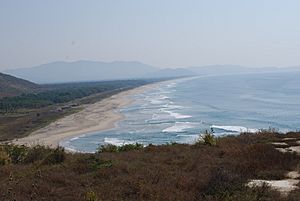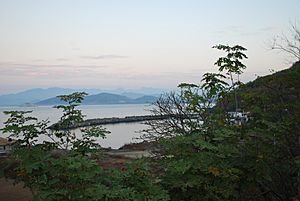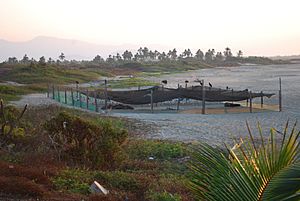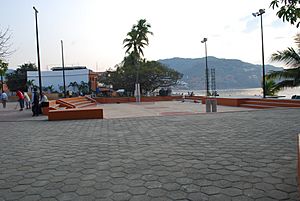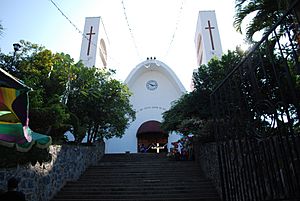Costa Grande of Guerrero facts for kids
The Costa Grande of Guerrero is a beautiful coastal area in the state of Guerrero, Mexico. It's one of seven special regions in the state. Guerrero's coast stretches for about 500 kilometers (310 miles) along the Pacific Ocean. This long coast is divided into two main parts: the Costa Grande and the Costa Chica. They are roughly separated by Acapulco. Even though Acapulco is a big city on the coast, the government usually considers it a separate region.
The Costa Grande includes seven different areas called municipalities. These are Atoyac de Álvarez, Coyuca de Benítez, José Azueta, La Unión, Petatlán, Benito Juárez/San Jerónimo, Coahuayutla de José María Izazaga and Tecpán de Galeana. Together, they cover an area of about 2,500 square kilometers (965 square miles).
Contents
Weather and Nature
The weather here is shaped by moisture coming from the Pacific Ocean. Most of this moisture falls as rain in the higher mountains. This rain then creates many rivers and streams that flow down to the coast and into the Pacific Ocean. Some water in the northern part flows into the Pacific through the Balsas River, which is on the border with Michoacán.
The plants and animals in the Costa Grande are very diverse. On land, you can find tropical forests, both evergreen and those that lose their leaves. There are also dry scrublands and sandy beach areas. In the lagoon areas, you'll see mangrove trees. The animals are also very varied, with many land and water species.
Exploring the Coastline
Many beaches along the Costa Grande are quite natural and undeveloped. This means they don't have many big hotels. Instead, you might find places to camp or simple bungalows. There are often open-air restaurants where you can enjoy fresh food.
There are no large lakes in this region. However, there are several lagoons along the coast. These lagoons are separated from the open ocean by a strip of land or beach. Important lagoons include those in Coyuca, Mitla, Tenexpa, Playa Blanca, and Potosí. Other smaller ones are San Valentin and El Tular. Most of the islands off the coast of Guerrero are also found in this region.
Main Towns and Cities
The most famous town on the Costa Grande is Zihuatanejo. It started as a fishing village and still has a busy fishing port and market today. It was once a port during the Spanish colonial period. However, Acapulco later became the main Pacific port for New Spain. Even with the nearby Ixtapa resort, Zihuatanejo has grown a lot. People feel it has kept its traditional Mexican charm more than Ixtapa.
Just north of Zihuatanejo is the old port of La Unión. Its original name was Zacatula. This was one of the first Spanish settlements on the Costa Grande in the early 1500s. However, local native people destroyed the first settlement. Today, La Unión is a rural area. Most people there make a living from farming, raising animals, and forestry.
The city of Petatlán is located southeast of Zihuatanejo, a bit inland. It serves as a commercial hub for the region. Petatlán is well-known for the Padre Jesús de Petatlán Sanctuary. This church holds a special image of Christ. People believe it appeared mysteriously long ago and has been linked to many miracles.
Coyuca de Benitéz is at the eastern end of the Costa Grande, close to Acapulco. It's a fairly large city. Historically, it was a strong base for rebels during the Mexican War of Independence. Today, its economy is based on being a commercial center for the area west of Acapulco. It also attracts many tourists.
Ancient History and Archeology
Not much archeological work has been done in the Costa Grande area compared to other parts of Mexico. However, recent discoveries show that this region might have been more important in ancient times than once thought. People have lived here since at least 2000 B.C.E.
The largest ancient site found so far is La Soledad de Maciel. This excavated site was likely a ceremonial center. Different ancient cultures used it over time, including the Tomiles, Cuitatecos, and Tepoztecas. Finds suggest the site was used for over 3,000 years. It also had connections with many other ancient Mesoamerican cultures.
Protecting these ancient sites along the Costa Grande is a challenge. Many sites lack security because of limited resources. Sometimes, local people take items they find from these sites. These items are then sold, and many end up in other countries. For example, a site in San Jerónimo had ancient stone monuments called stele that were taken.
How People Make a Living
Farming, Food, and Forests
The land in the Costa Grande is very fertile. Farming and raising animals are the main ways people earn money in most areas. Coffee is a major crop, mostly grown on small farms. Many coffee plants are old, which means they don't produce as much coffee as they could. Atoyac is a big center for coffee production and processing in the region.
Coconut trees were brought here from the Philippines long ago. Coconut farms still cover much of the coast. Drying coconut kernels, called copra, is one of the few widespread industries here. Other crops grown include corn, tropical fruits, sesame seeds, citrus fruits, melons, tamarind, and hibiscus flowers. Rice and sugar cane are grown in Tecpan. People also raise cattle for meat and milk. Making honey is a traditional product, and there's even a beehive construction business in Atoyac.
The area is also important for its forest products. Most of the trees harvested are pines, holm oaks, and oyamel firs.
Fishing and Seafood
The Costa Grande, along with the rest of Guerrero's coast, is a nationally important source of seafood. Major fishing communities are found in Petacalco and Zihuatanejo. Fishermen catch species like shark, sailfish, huachinango, sea bass, mojarra, octopus, shrimp, lobster, clams, and crabs. Other big fishing areas include Barra Potosí, Playa Azul, El Carrizal, la Barrita, La Laguna, El Camalote, and El Embarcadero in Coyuca. Zihuatanejo has a major fishing port and fish market. It's also a popular spot for sports fishing. Shrimp fishing and farming are important in the Atoyac municipality, especially in areas like Mexcaltepec, Agua Fria, and Junda de los Rios.
Local Businesses
There isn't a lot of big industry in the area. Most businesses focus on food production and making ice, mainly for local needs. You can find furniture making in Coyuca and Tecpan. There's a soap factory in San Jeronimito, Petatlán, and a facility that makes animal feed in Tecpan. Most shops and services in the towns are for local residents. Some hotels and restaurants cater to tourists along the beaches.
Fun for Tourists
The main tourism hub (not counting Acapulco) is the popular pair of Ixtapa and Zihuatanejo. Since the mid-1900s, these beaches have been traditional vacation spots for Mexican travelers. Troncones and nearby beaches attract surfers, backpackers, and those who like a more relaxed vibe. Less developed beach areas like Barra Potosí and Playa Michigan are popular with young travelers. Coyuca also has some tourist facilities. However, most other beaches on the Costa Grande only have open-air restaurants and maybe one or two places to stay. Some beaches are almost completely empty.
Since 2008, the state government has been creating artificial reefs off the coast. They use cement blocks to do this. The idea is to create new attractions for divers and help the local environment by increasing the variety of sea life. The first blocks were placed in Acapulco. By March 2010, over 300 modules had been placed in various parts of the Costa Chica. Artificial reefs are also planned for areas of the Costa Grande, including Petacalco, Ixtapa, Zihuatanejo, Playa Ventura, and Puerto Vicente Guerrero.
Besides La Soledad de Maciel, there are other ancient ruins scattered along the coast. Zihuatanejo has a museum dedicated to the archeology of the region.
|
See also
 In Spanish: Costa Grande para niños
In Spanish: Costa Grande para niños


